Written by Don Richardson

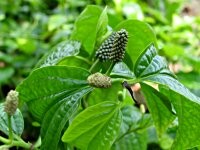 Pepper Leaf (Piper Sarmentosum)
Pepper Leaf (Piper Sarmentosum)Plant Type | Perennial Vine |
Size | 30’ tall, 8’ wide |
Sun Exposure | part sun – full shade |
Soil Type | sand, loam |
Soil pH | 5.0-7.0 acidic – neutral - loam |
Bloom Time | Summer - Fall |
Hardiness Zones | 8a-11 Food Forest Plant |
Moisture | Moist, rich, well drained |
Cold/Heat | 15°F – |
Pollination | Self-pollinates |
Edible Plant | Yes – Raw or cooked spice |
Medicinal Plant | Yes |
Any reference to medicinal or culinary use of plants or plant parts should in no way be considered an endorsement by The Ocala Food Forest or its staff. Research is crucial in safe and proper consumption or experimentational use of any plant.
The Piper Sarmentosum, also known as the Pepper Leaf or Betel Leaf plant, is a species of flowering vine native to Southeast Asia. It is most commonly used as a flavoring and aroma enhancer in traditional Asian dishes such as laksa and nasi lemak. This plant has been used for centuries in traditional medicine and cuisine and has gained popularity recently due to its purported health benefits. In this blog post, we will explore what exactly the Piper Sarmentosum is, how it can be used, and why it should be included in your diet.
Description of the Plant
The Piper Sarmentosum is an evergreen vine that grows mainly in tropical climates such as Malaysia and Indonesia. It belongs to the pepper family and is closely related to black pepper. Its leaves are glossy green with a pointed tip and have a unique flavor. Its taste has been described as sweet, spicy, and sour all at once. The flavor is often compared to that of peppermint or green tea with a slight bitterness. The plant also produces small white flowers that have a sweet smell.
Traditional Uses
For centuries, the Piper Sarmentosum has been used in traditional medicine and cuisine across Southeast Asia. In terms of medicinal uses, the leaves are said to have anti-inflammatory properties that can help reduce pain and inflammation in the body. They are also believed to have antibacterial properties that can help fight off infections caused by bacteria. Additionally, consuming Piper Sarmentosum has long been thought to improve digestion and overall health.
In terms of culinary uses, one of the most popular dishes made using Piper Sarmentosum leaves is curry laksa – a spicy noodle soup dish popular throughout Malaysia. The leaves are added to give the soup an extra tangy kick while still providing a balanced flavor profile. The leaves can also be eaten raw or cooked into other dishes such as stir fries or salads.
Health Benefits
The Piper Sarmentosum plant is full of antioxidants and vitamins C, E and B-complex which are essential for a healthy diet. Recent studies suggest that consuming Piper Sarmentosum may offer various health benefits due to its high concentration of polyphenols – compounds found naturally occurring in plants shown to have antioxidant, anti-inflammatory, and anti-cancer properties. Additionally, it’s been hypothesized that the polyphenols found in this plant may improve cardiovascular health by reducing levels of bad cholesterol (LDL) while increasing levels of good cholesterol (HDL) as well as blood sugar levels in those with type 2 diabetes. Other potential health benefits include lower blood pressure levels, improved digestive health, enhanced immunity against infection, and reduced risk for certain types of cancer.
Conclusion:
There are many reasons why the Piper Sarmentosum plant should be included in your diet including its health benefits and unique flavor profile. It adds an interesting twist to traditional Asian dishes while providing valuable nutrients that are beneficial for your health. So next time you’re at the grocery store, consider picking up some Pepper Leaf! for culinary inspiration or want to take advantage of its potential health benefits – incorporating more Pepper Leaf plants into your diet might just be worth it!
There are many reasons why the Piper Sarmentosum plant should be included in your diet including its health benefits and unique flavor profile. It adds an interesting twist to traditional Asian dishes while providing valuable nutrients that are beneficial for your health. So next time you’re at the grocery store, consider picking up some Pepper Leaf! for culinary inspiration or want to take advantage of its potential health benefits – incorporating more Pepper Leaf plants into your diet might just be worth it!
Written by Don Richardson

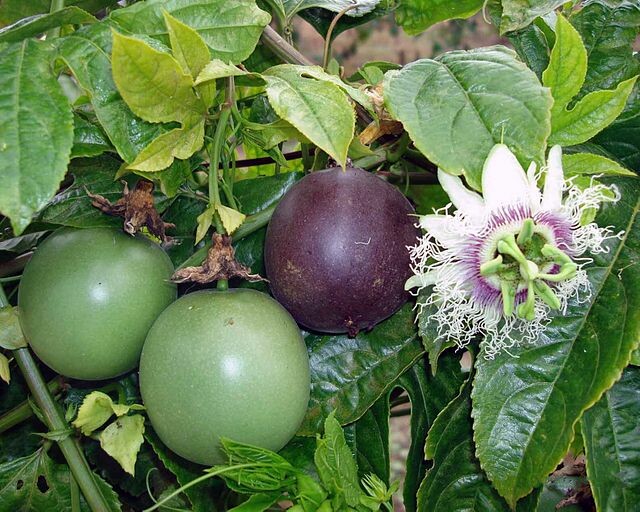 Passion Fruit (Passiflora Edulis) Purple Possum
Passion Fruit (Passiflora Edulis) Purple PossumPlant Type | Perennial Vine |
Size | 30’ tall |
Sun Exposure | part shade – full shade |
Soil Type | sand, loam |
Soil pH | 5.5-7.5 acidic - neutral |
Bloom Time | Most all year, harvest in fall |
Hardiness Zones | 9-12 Food Forest Plant |
Moisture | Moist, rich, well drained |
Cold/Heat | 25°F – |
Pollination | Self-pollinates |
Edible Plant | Yes |
Medicinal Plant | Yes |
Any reference to medicinal or culinary use of plants or plant parts should in no way be considered an endorsement by The Ocala Food Forest or its staff. Research is crucial in safe and proper consumption or experimentational use of any plant.
The Passiflora Edulis, commonly known as the passion fruit plant, is a beautiful and fragrant vining plant native to South America. It's a member of the Passifloraceae family, which contains over 500 species of plants. This plant produces an edible fruit that has become popular around the world for its sweet and tart flavor. This article will provide an overview of the Passiflora Edulis and discuss its many benefits.
Origins of the Passiflora Edulis Plant
The Passiflora Edulis is believed to have originated in Paraguay and southern Brazil before being spread throughout South America and other regions by Spanish missionaries. It was first introduced to Europe in 1771 by French Botanist Charles Plumier and later spread to other parts of the world. Today, Passion Fruit is cultivated in tropical climates across the globe from Southeast Asia to North America.
Characteristics of the Plant
The Passiflora Edulis vine can grow up to 30 feet in length with intricate leaves that range from 5-9 inches long. The flowers are white on top with purple petals that measure 2-3 inches in diameter. The flowers are very fragrant and attract hummingbirds, butterflies, and bees. The fruit itself is round or ovoid shape with a yellow or dark purple skin depending on the variety. Inside each fruit you will find hundreds of seeds surrounded by a sweet yet tart pulp which can be used fresh or processed into juices, jams, jellies, and syrups.
Fruit Production & Uses
The Passiflora Edulis plant requires warm temperatures between 65–90°F (18–32°C) for growth and optimum yields of fruit production can be achieved when temperatures are between 75-85°F (24-29°C). The fruits are usually harvested once they turn yellow or dark purple and drop off their vines naturally. Afterwards they may be sold fresh or processed into various products such as juice concentrate, jams, jellies, ice creams, smoothies, sauces, syrups, liqueurs and other culinary preparations because of its intense flavor and aroma.
The Passiflora Edulis has been used for centuries in folk medicine due to its high content of vitamins A and C as well as minerals such as calcium and phosphorus. It's also used in teas due to its calming effects on the body and mind. Additionally, the oil from the seeds is often extracted for use in cosmetics and perfumes due to its moisturizing properties.
Growing & Care Tips
The Passiflora Edulis grows best in warm climates with plenty of sunlight but can tolerate light shade for part of the day. It prefers well-drained soil that's high in organic matter (like compost) but can tolerate some clay if drainage is adequate. To keep your passion fruit plant healthy, it's important to water regularly (especially during dry spells) but avoid over-watering as this can lead to root rot or other fungal diseases. Additionally, you should periodically prune back any overgrown vines to encourage new growth while keeping a neat appearance. Finally, be sure to fertilize at least once every two months using a good quality fertilizer specifically formulated for passion fruits plants or citrus trees (which share similar nutritional needs).
Conclusion:
In conclusion, the Passiflora Edulis (Passion Fruit Plant) is an attractive evergreen vine that produces fragrant flowers followed by edible fruit packed full of nutrients. Not only does it have medicinal uses but also culinary applications due to its strong flavor profile making it perfect for jams and jellies as well as liqueurs or even cosmetics! With proper care this beautiful plant can thrive indoors or outdoors bringing color and life wherever it grows! If you're looking for an easy-to-care-for plant that packs a punch with flavor, then look no further than the Passiflora Edulis!
In conclusion, the Passiflora Edulis (Passion Fruit Plant) is an attractive evergreen vine that produces fragrant flowers followed by edible fruit packed full of nutrients. Not only does it have medicinal uses but also culinary applications due to its strong flavor profile making it perfect for jams and jellies as well as liqueurs or even cosmetics! With proper care this beautiful plant can thrive indoors or outdoors bringing color and life wherever it grows! If you're looking for an easy-to-care-for plant that packs a punch with flavor, then look no further than the Passiflora Edulis!
Written by Don Richardson

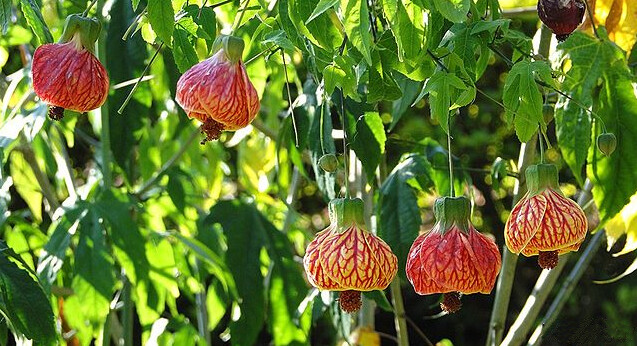 Parlor Maple (Abutilon Striatum)
Parlor Maple (Abutilon Striatum)Plant Type | Perennial Shrub |
Size | 6-10’ tall, 4-8’ wide |
Sun Exposure | Full sun – part shade |
Soil Type | sand, loam, chalk |
Soil pH | 5.6-6.0 acidic - alkaline |
Bloom Time | Summer - Fall |
Hardiness Zones | 8-11 Food Forest Plant |
Moisture | Moist, rich, well drained |
Cold/Heat | 20°F – |
Pollination | Self-pollinates |
Edible Plant | Yes (Flowers raw or cooked) |
Medicinal Plant | Yes |
Any reference to medicinal or culinary use of plants or plant parts should in no way be considered an endorsement by The Ocala Food Forest or its staff. Research is crucial in safe and proper consumption or experimentational use of any plant.
If you’re looking for a low-maintenance houseplant that doesn’t require a lot of attention, then look no further than the Abutilon Striatum, also known as the Parlor Maple. This plant features lush green foliage and vibrant blooms throughout the year, making it an ideal choice for anyone who wants to add a bit of tropical vibes to their living space! Let’s take a closer look at this beautiful houseplant.
Appearance:
The Abutilon Striatum is an evergreen shrub with smooth oval leaves that are slightly serrated on the edges. Its leaves are dark green in color and can reach up to 6 inches in length if left unpruned. In late spring and early summer, this plant produces bright yellow bell-shaped flowers with red veining that are sure to add life to any space!
Care Instructions:
The Parlor Maple is easy to care for and requires minimal maintenance. It prefers bright indirect sunlight or partial shade and well-drained soil that is slightly acidic (pH 5.6-6.0). Water when the top inch of soil feels dry and feed once every three months during its active growth period (spring through fall). Prune back any dead or damaged foliage when needed; otherwise, there is no need for pruning. This plant is also resistant to pests, making it a great choice for indoor growing!
Uses:
The Abutilon Striatum makes an excellent addition to any home or office space due to its beauty and low maintenance needs. It can be grown indoors or outdoors as long as it is kept away from direct sunlight or frosty temperatures. The foliage can also be used in flower arrangements due its vibrant colors and delicate texture. Finally, this plant has been known to purify the air quality inside your home by removing toxins such as formaldehyde, benzene, and xylene from the air around it - making it even more beneficial for our health!
Conclusion:
The Abutilon Striatum is an ideal choice for anyone looking for an easy-care houseplant that adds life and color into their home, garden, or office space. Not only does it require minimal upkeep while providing beautiful blooms throughout the year, but it also offers numerous health benefits such as air purification and stress relief! Whether you’re a novice gardener or a seasoned pro, you’ll find that these plants are fun and rewarding additions to any indoor environment!
The Abutilon Striatum is an ideal choice for anyone looking for an easy-care houseplant that adds life and color into their home, garden, or office space. Not only does it require minimal upkeep while providing beautiful blooms throughout the year, but it also offers numerous health benefits such as air purification and stress relief! Whether you’re a novice gardener or a seasoned pro, you’ll find that these plants are fun and rewarding additions to any indoor environment!
Written by Don Richardson

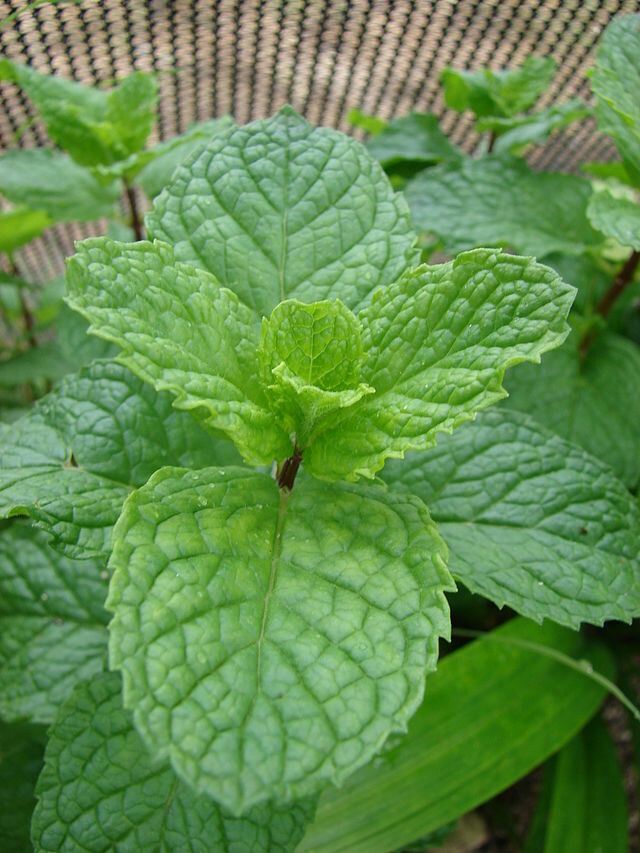
Mint (Mentha Spicata) 'Spearmint'
Plant Type | Perennial Herb/Ground Cover |
Size | 1-3’ tall, 1-2’ wide, spreads |
Sun Exposure | Full sun – part shade (3hrs.+) |
Soil Type | Light sand, loam, clay |
Soil pH | 6.0-7.0 acidic - alkaline |
Bloom Time | Summer - Fall |
Hardiness Zones | 3a-10 Food Forest Plant |
Moisture | Moist, well drained |
Cold/Heat | -30°F – |
Pollination | Self-pollinates, self-seeds |
Edible Plant | Yes |
Medicinal Plant | Yes |
Any reference to medicinal or culinary use of plants or plant parts should in no way be considered an endorsement by The Ocala Food Forest or its staff. Research is crucial in safe and proper consumption or experimentational use of any plant.
The Mentha spicata, more commonly known as the spearmint plant, is a species of mint that has a long history of medicinal and culinary uses. It is native to Europe and Asia, but it can now be found in many parts of the world. In this blog post, we’ll take a closer look at this versatile plant and explore its many benefits.
History and Origin of the Spearmint Plant
The spearmint plant has been used for thousands of years for its medicinal properties. Ancient Greek and Roman cultures both used spearmint as an herbal remedy for a variety of ailments, including digestive issues and headaches. The plant was even mentioned in ancient texts such as Theophrastus’ Historia Plantarum, written in 300 BC.
Description
The Spearmint plant grows up to 30-90 cm tall and has greenish or reddish stems with serrated oval leaves. The leaves can be either opposite or in whorls of three, while the flowers are usually pink or lilac in color. It thrives best in moist soils but can survive in most soil types. It also requires plenty of sunlight and will begin to flower between mid-summer and late summer when temperatures remain consistently warm.
Culinary Uses
The oil from the leaves of the Spearmint plant is widely used as a flavoring agent in many culinary applications such as candy, gum, ice cream, toothpaste, tea, liqueurs and sauces. While it shares some flavor notes with peppermint (Mentha Piperita), it has a much sweeter taste than its close cousin due to lower concentrations of menthol. For that reason, spearmint is often favored by people who may find peppermint too overpowering for their tastes.
Medicinal Properties
Spearmint has been used medicinally since ancient times and is believed to have many health benefits including aiding in digestion, reducing muscle spasms, relieving headaches and congestion, treating skin irritations and improving oral health. In addition, it contains high amounts of vitamin A which helps promote healthy skin growth as well as antioxidants which helps fight against free radicals that damage cells over time. Finally, research suggests that consuming spearmint tea regularly may help reduce levels of bad cholesterol (LDL) while raising levels of good cholesterol (HDL). It can also be made into essential oil that can be added to bath water or massaged into the skin for relaxation purposes.
Conclusions:
All in all, the Spearmint plant provides not just flavorful culinary experiences but also much needed medicinal properties for our overall well-being too! Whether you’re looking for a unique way to liven up your dishes or want a natural remedy for common ailments like headaches and digestion issues - look no further than the humble Spearmint plant! With proper care this versatile species can provide you with plenty of delicious flavors and therapeutic benefits for years to come!
All in all, the Spearmint plant provides not just flavorful culinary experiences but also much needed medicinal properties for our overall well-being too! Whether you’re looking for a unique way to liven up your dishes or want a natural remedy for common ailments like headaches and digestion issues - look no further than the humble Spearmint plant! With proper care this versatile species can provide you with plenty of delicious flavors and therapeutic benefits for years to come!
Written by Don Richardson

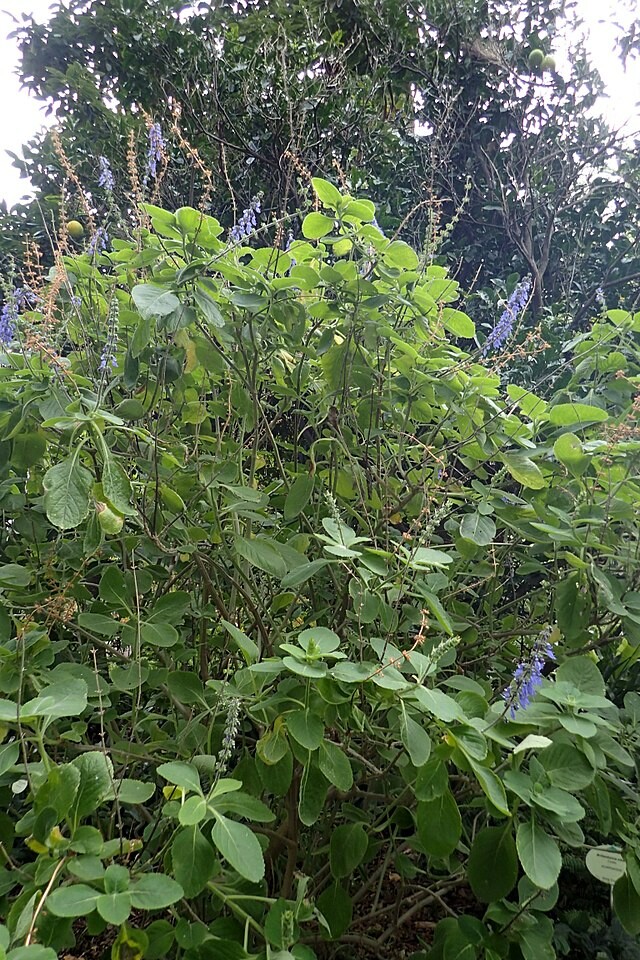
Toilet Paper Plant (Plectranthus Barbatus)
Plant Type | Perennial Shrub |
Size | 6-8’ tall, 4’ spread |
Sun Exposure | Full sun – part shade |
Soil Type | Light sand, loam, clay |
Soil pH | 6.0- acidic - neutral |
Bloom Time | Summer - Fall |
Hardiness Zones | 9-11 Food Forest Plant |
Moisture | Moist, well drained, drought |
Cold/Heat | 25°F – protect under 32°F |
Pollination | Spreads by offshoots |
Edible Plant | Yes - Roots |
Medicinal Plant | Yes |
Any reference to medicinal or culinary use of plants or plant parts should in no way be considered an endorsement by The Ocala Food Forest or its staff. Research is crucial in safe and proper consumption or experimentational use of any plant.
Have you ever heard of the Plectranthus Barbatus? Also known as the Toilet Paper plant, this unique and attractive flowering plant is native to South Africa and has been gaining popularity in recent years. It's easy to see why; with its bright green foliage and striking white flowers, it's an eye-catching addition to any home or garden. But what else do we know about this fascinating plant? Let’s take a closer look at the Plectranthus Barbatus and find out.
Physical Characteristics
The Plectranthus Barbatus is an evergreen perennial with fleshy stems and glossy, heart-shaped leaves that are typically a vibrant shade of green but can sometimes have reddish or purple tints. This plant produces clusters of white flowers that have a mild, sweet scent, resembling those of mint or oregano. Its flowers can bloom all year round if the weather permits, although they typically bloom in late summer or early fall. The Toilet Paper plant grows quickly and can reach heights of up to three feet tall when mature.
Care Instructions
The Toilet Paper plant is relatively easy to care for compared to other types of plants, as long as its basic needs are met. It should be planted in well-drained soil in a location that receives full sun or partial shade; too much shade will cause the foliage to become leggy and sparse. When watering your Plectranthus Barbatus, make sure not to overdo it; too much water can lead to root rot. Additionally, fertilize the soil every two weeks during the growing season for best results.
Uses for This Plant
In addition to its decorative value, there are several practical uses for the Toilet Paper plant. Its leaves contain oils that are used in traditional medicine to treat fever and headaches; these oils also have antibacterial properties which make them useful for treating skin conditions such as acne and eczema. Additionally, some people use the leaves of this plant as toilet paper due to their soft texture! As if that weren’t enough, it’s also commonly used as an ornamental border along paths or walkways due to its low maintenance requirements and attractive appearance.
Conclusion:
From traditional medicinal uses to simply adding some greenery indoors or outdoors, there are plenty of reasons why you might want a Plectranthus Barbatus - otherwise known as the toilet paper plant - in your home or garden! With its bright green foliage and beautiful white flowers that bloom all year round if weather permits it's no wonder why this unique flowering plant has become so popular lately - so don't miss out on this one-of-a-kind opportunity! Give your home an extra touch of beauty with a Toilet Paper Plant today!
From traditional medicinal uses to simply adding some greenery indoors or outdoors, there are plenty of reasons why you might want a Plectranthus Barbatus - otherwise known as the toilet paper plant - in your home or garden! With its bright green foliage and beautiful white flowers that bloom all year round if weather permits it's no wonder why this unique flowering plant has become so popular lately - so don't miss out on this one-of-a-kind opportunity! Give your home an extra touch of beauty with a Toilet Paper Plant today!








